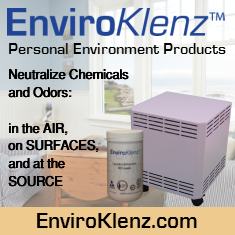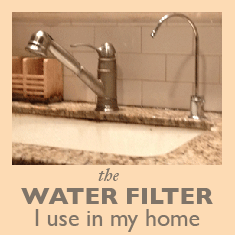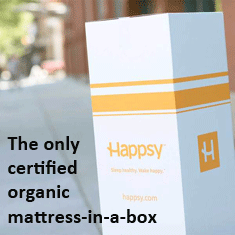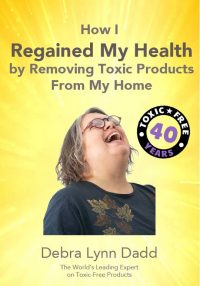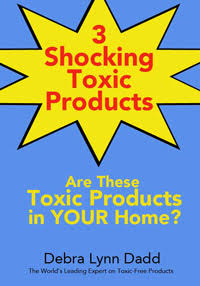
Water | Swimming Pools
Those black mark thingies on my dishes
Question from CJStewart
We recently replaced our old dishes with white Fiesta Ware. We really like them, but our forks and spoons leave those black (gray) marks on them. Is there a green way to remove those marks? I have tried Bon Ami without success.
Debra’s Answer
I don’t have an answer to this one, but I will share an observation.
I don’t get black marks on my dishware. I use silverplate flatware.
But I do get those grey marks on the inside of mixing bowls that I have used with my hand mixer, which has stainless steel beaters. I think it’s the stainless steel.
Readers, any success removing these marks?
Tried and True Wood Finishes
Question from Jennifer L.
Hello Debra,
My husband and I bought the “Trued and True” varnish and danish oil to finish our hardwood floor, due to concerns over our baby’s health while crawling. We hired a “professional” to do the work and unfortunately he did not follow the directions, and left it puddling on the floor for days! The floor has taken weeks to dry after wiping it clean.
Although it is now dry, there is a lingering odor that smells like the linseed oil. My question is, do you believe the smell/fumes to be harmful to little lungs even though it has been described as one of the least toxic floor finish by several sources? It is a no VOC product but the smell is so strong!
I should also mention that we are not moved into the house yet and we are turning the heat on 80 degrees at night with the windows closed and opening up the house during the day. I am afraid to turn the heat up too high for a bake out. Is this temperature OK?
Thanks very much for any help and advise you can give us!
–Jennifer
Debra’s Answer
This looks like a wonderful wood finish from the description on the Tried & True Wood Finishes website. All renewable resources, no VOCs, even meets the FDA food safe standards.
There’s nothing toxic here that I can see.
However, I have had experience in the past using other all-natural paints and wood finishes made from natural oils and resins as these are, and I find the odors from the natural resins themselves can be very strong. And they can take a long time to completely cure.
The instructions say to use a very small amount, so if instructions were not followed, there may be more resin offgassing than intended.
You’re going in the right direction with the heat.
I have no personal experience with this product. You can always contact the manufacturer with this kind of question. They should be able to tell you exactly what to do.
European Chemical Clampdown Reaches Across Atlantic
Question from Julie Larson
Scientific American
September 30, 2008
European Chemical Clampdown Reaches Across Atlantic
Many chemicals manufactured in the U.S. have been pronounced “dangerous” by the European Union
By David Biello
This came to me from Lawrence Plumlee via Dr Paula Davey.
Debra’s Answer
Cleaning Pinworm Eggs
Question from Mom
My son has pinworm and the eggs are hard to kill. Every site I’ve seen says to use bleach, but I’m sensitive to it, plus I don’t use toxic cleaners like these.
I’ve been using white vinegar. Will this kill the eggs while cleaning? Do I need to use it full strength?
I’ve also read that sunlight will kill the eggs, but no mention of how long items need to be in sunlight. Any idea?
And I’ve also read that heating the house to 95 degrees can kill the eggs, but also no mention of the amount of time necessary.
Any other ideas you have are appreciated.
Thank you.
Debra’s Answer
I have no experience with this. Readers?
Plastic Smell in Carpet
Question from Sandy
My husband and I decided to switch our office and guest room. The office (which is now the guest room) had one of those plastic things you put on the floor so your chair can roll easily. It has been in the room for several years and had no plastic smell. When we picked it up off the floor the odor was horrendous and won’t go away. It has been about 6 weeks and we have tried airing out the room, running a fan, putting baking soda down and have now cleaned the carpet with Mystical carpet stain remover. The plastic smell now seems worse, altho the carpet may still be damp. Is there a way to get the plastic smell out once and for all w/o adding any chemicals to the mix? I have MCS.
Debra’s Answer
None of the things you list do anything to remove an odor from carpet. Airing the room, for example, will remove the pollutants released from the carpet from the room, but will not stop them from being released from the carpet.
I suggest using a space heater to heat the room, especially if you think the carpet is still damp. This will help the odor outgas and dry the carpet.
If this does not eliminate the odor, you can contain it with AFM Carpet Seal. This is a nontoxic product that smells like nothing. I used it many years ago on a carpet in an office and it was very effective.
Lead in Old China
Question from SVE
Older relatives have given us various decorative collector china plates, tea cups and saucers (some “chintz” patterns) through the years. I’ve been wondering if “lead” could be on the surfaces of some or most of these lovely pieces. If a person only touches these when they are dry, would the lead transfer to the fingers? Only very occasionally would they be washed. Does water release the lead from the surfaces onto the fingers? In short, can a person become exposed to lead from old china (that is never used for food or drink) by simply touching them?
Debra’s Answer
IF there is lead in the finish, yes, it could get into your body by simply touching them.
You can verify if there is lead by testing with LeadCheck swabs.
Lotus Sanitizing System
Question from Shelly
Hello,
I am interested in reading about anyone’s experience with a Tersano Lotus LBU100 Sanitizing System? It is supposed to disinfect surfaces as well as remove pesticides and kill germs on food.
According to what I have read about the Lotus, cold tap water has an extra oxygen atom added to it in order to create ozone. Ozone is not something I want in an air purifier due to respiratory reasons however this is not supposed to be an issue with this technology since the ozone is in the water. Yet, I still wonder about the safety. Does anyone know about the safety issue of the ozone in the water? I would love to hear your view Debra.
Thank you.
Debra’s Answer
According to the Lotus website, what their product does is infuse tap water with ozone.
I know a lot about ozone in water because my late father actually received a patent for using ozone to disinfect water.
Ozone in water is safe and will kill bacteria and germs of all kinds on household surfaces, so it can be used in place of more toxic disinfectants.
However, this product also claims to significantly reduce pesticide residues on the produce. I just want you to note that they say on the surface of produce. And then they go on to say, “With the lotus system, expensive “organic” isn’t the only way to enjoy food with less pesticides!”
My issue here has to do with their creating an impression that eating foods cleaned with ozonated water is the same as eating organic produce. It’s not. It’s not even close. What ozonated water will do is remove some pesticides from the surface of the produce. But pesticides are sprayed repeatedly throughout the growing of produce and so it is systemic within the entire fruit or vegetable. It’s not just sprayed on top. In addition, organic produce is grown in soil that is full of nutrients, so organic food actually contains more nutrients and comes from healthy plants. And in the bigger picture, organic foods don’t put pesticides into the air, soil, and water, from which they come to us indirectly.
Also, they talk about using plain tap water, which is full of toxic pollutants that you don’t want to put on your food.
Caulk
Question from Diana
I just recently purchased a “non-toxic” caulk from a site listed on “Debra’s List.” However, after I read the back of the bottle it lists the following items: “Contains TALC, 2,2,4-TRIMETHYL-1, 3-pentanediol MONO-SOBUTYRATE, VINYL ACETATE AND ACETALDEHYDE. MAY ALSO CONTAIN CARBON BLACK OR TITANIUM DIOXIDE.” OK this concerns me because I don’t really know what any of the above exactly means. Is this safe enough to use? Meaning, will it be safe after it dries? Or should I send it back? I was unable to download the MSDS from their website.
Also, I saw another reader to this blog tried the DAP Painters Acrylic Latex Caulk. Did it work for you? Any help would be much appreciated. We are trying to start our child’s bedroom and we want it as safe as possible for him.
Diana
Debra’s Answer
To answer your specific question first, these are all hazardous substances. That’s why they are listed–as a warning. Is it safe enough to use? You may not find a safer one. Yes, it will be safe after it dries. You can also use heat to make it dry faster.
It’s important for us to find the least toxic caulks available, because caulk is widely used throughout homes to block out air and water and fill gaps between building materials.
Unfortunately, I have yet to find what I would consider a nontoxic caulk. There was one we liked made by DAP, but I can’t seem to find it any more.
A lot of things are changing in the world of caulk. Not so long ago there were only three basic ingredients used to make caulk: acrylic, latex, and silicone. Now there are also synthetic rubber caulks and modified silicone caulks…
But the one thing we are most interested in is toxicity. And with regard to that, caulks fall into two categories: water-based and solvent-based.
Water-based caulks are made from latex (which includes acrylic and vinyl, both of which are toxic). They clean up with water and have less odor, but they are still toxic (I’ve heard and read that they are “nontoxic,” but this simply isn’t so).
Mice control
Question from Sue McWilliams
I read an article explaining to dip cotton in peppermint oil and place in areas likely to attract rodent traffic. Cleaned up my laundry room and placed several in the room. I used pieces of a cotton t-shirt tied in a small bundle and saturated with the peppermint oil. My laundry room smells nice, but since this is the first time I have tried this, I was wondering how often I would have to do this. Will these last me throughout the winter months? Thanks!
Debra’s Answer
I’ve never tried this, but I would imagine that you would need to periodically refresh the peppermint oil. Probably every month or two.
Low/no VOC Clear Sealer For Deck
Question from Sunnyside
I’m looking for a non-toxic, low(or no) VOC sealer that can be used to cover our newly installed deck floor. The deck floor is a hardwood (maple)from Brazil light in color. It is a very dense wood and pre-drilling was necessary. If possible, I would like to seal this yet this fall before the Michigan winter sets in.
I did check with Vermont Natural Coatings but they do not have a product for the outside at this time. Any suggestions would be greatly appreciated. Thank you.
Debra’s Answer
Readers? I don’t have experience with this as I don’t have a deck.

